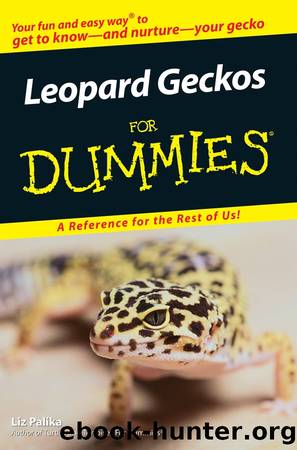Leopard Geckos For Dummies by Liz Palika

Author:Liz Palika
Language: eng
Format: epub
Publisher: Wiley
Sand is heavy so make sure the supports under your geckoâs cage can hold the weight. When cleaning the cage, scoop the sand out, donât try to lift the cage with the sand in it; the bottom can drop out.
Baby geckos should not be housed on sand, even calcium sand, because the long-term safety is not known. An intestinal impaction is a very real possibility. Use paper towels (see below) instead.
Paper towels and newspapers: Paper towels are the most inexpensive bedding you can use and probably the ugliest, too. Even the decorator ones! However, most leopard gecko breeders house their newly hatched geckos on paper towels because they are inexpensive, very safe, and easy to clean from the cage. For babies, paper towels are the best choice. For adults, it makes for a very unattractive cage.
Newspapers are also used quite often, again, because they are easily available and cheap. I do have some concerns about the inks used on many newspapers. They are supposed to be safe, but I know of no long-term studies showing the safety of the ink in regards to reptiles. I would use newspapers with caution and only for short-term use (for a day or two).
Recycled newspaper beddings are manufactured for use with reptiles and other small animals. They are lightweight, absorbent, and completely safe. They do not get moldy and are dust free. The drawbacks are the price (they are not cheap), and they have a musty odor, which some people find objectionable. Also, they tend to be unattractive. (They are gray and look like crumpled, shredded paper.)
Download
This site does not store any files on its server. We only index and link to content provided by other sites. Please contact the content providers to delete copyright contents if any and email us, we'll remove relevant links or contents immediately.
| Birds | Cats |
| Dogs | Essays |
| Fish & Aquariums | Food & Nutrition |
| Horses | Insects & Spiders |
| Mice, Hamsters & Guinea Pigs | Pet Loss |
| Rabbits | Reptiles & Amphibians |
Finding Gobi by Dion Leonard(2268)
Grumpy Cat by Grumpy Cat(2135)
The Silkworm by Robert Galbraith(2014)
A New Earth: Awakening to Your Life's Purpose by Eckhart Tolle(1982)
End of Days by Sylvia Browne(1830)
Tippi by Tippi Hedren(1774)
Total Cat Mojo by Jackson Galaxy(1692)
Backyard Chickens Beyond the Basics by Pam Freeman(1619)
The Animals Among Us by John Bradshaw(1512)
The Ultimate Pet Health Guide by Gary Richter(1436)
Vet in Harness by James Herriot(1390)
Cesar's Way by Cesar Millan(1371)
Dog Years by Mark Doty(1367)
Doggy Desserts: 125 Homemade Treats for Happy, Healthy Dogs by Cheryl Gianfrancesco(1364)
All Things Bright and Beautiful by James Herriot(1313)
Chicken Soup for the Ocean Lover's Soul by Jack Canfield(1296)
Walking with Peety by Eric O'Grey(1290)
Dog Training 101 by Kyra Sundance(1270)
Encyclopedia of Dog Breeds by D. Caroline Coile Ph.D(1185)
